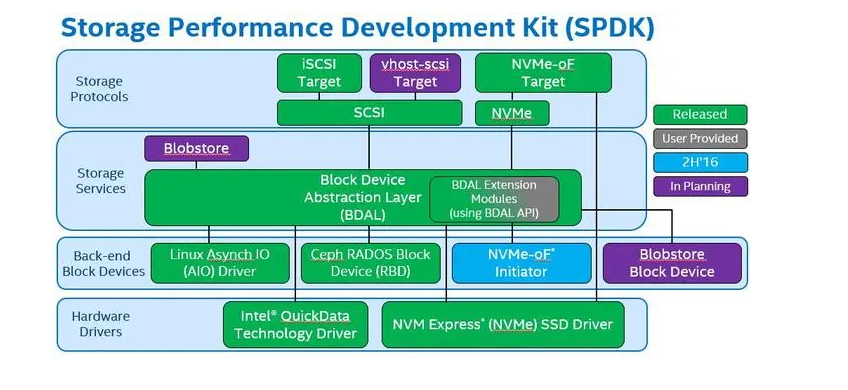下面是一个简单的DPDK KNI使用示例,包含详细注释:
”`
#include
// DPDK相关头文件
#include
#define RX_RING_SIZE 1024 #define TX_RING_SIZE 1024
#define NUM_MBUFS 8192 #define MBUF_CACHE_SIZE 256
#define BURST_SIZE 32
// KNI设备名字 #define KNI_DEV_NAME “vEth0”
static const struct rte_eth_conf port_conf_default = {
.rxmode = { .max_rx_pkt_len = ETHER_MAX_LEN }
};
static struct rte_mempool *mbuf_pool;
/**
程序初始化,包括DPDK环境初始化和KNI设备的创建。 */ static int init(int argc, char **argv) { int ret; unsigned nb_ports; uint16_t portid; struct rte_eth_dev_info dev_info; struct rte_kni_conf conf; struct rte_kni_ops ops;
// 初始化EAL(Environment Abstraction Layer) ret = rte_eal_init(argc, argv); if (ret < 0) {
rte_exit(EXIT_FAILURE, "Error: %s\n", strerror(errno)); return -1;}
argc -= ret; argv += ret;
// 获取网卡数量,并检查是否有符合要求的网卡 nb_ports = rte_eth_dev_count_avail(); if (nb_ports == 0) {
rte_exit(EXIT_FAILURE, "No Ethernet ports - bye\n"); return -1;}
// 配置KNI设备 conf.addr = NULL; conf.id = 0; snprintf(conf.name, RTE_KNI_NAMESIZE, “%s”, KNI_DEV_NAME); ops.port_id = 0;
// 创建KNI设备 if (rte_kni_init(nb_ports, &conf) < 0) {
rte_exit(EXIT_FAILURE, "Error: %s\n", strerror(errno)); return -1;}
// 获取网卡信息,并开启网卡端口 for (portid = 0; portid < nb_ports; portid++) {
memset(&dev_info, 0, sizeof(dev_info)); rte_eth_dev_info_get(portid, &dev_info); ret = rte_eth_dev_configure(portid, 1, 1, &port_conf_default); if (ret != 0) { printf("Cannot configure device: err=%d,port=%u\n", ret, portid); return -1; } ret = rte_eth_rx_queue_setup( portid, 0, RX_RING_SIZE, rte_eth_dev_socket_id(portid), NULL, mbuf_pool); if (ret < 0) { printf("Cannot init RX queue: err=%d,port=%u\n", ret, portid); return -1; } ret = rte_eth_tx_queue_setup( portid, 0, TX_RING_SIZE, rte_eth_dev_socket_id(portid), NULL); if (ret < 0) { printf("Cannot init TX queue: err=%d,port=%u\n", ret, portid); return -1; } /* Start the Ethernet port */ ret = rte_eth_dev_start(portid); if (ret < 0) { printf("Cannot start device: err=%d,port=%u\n", ret, portid); return -1; } /* Enable RX in promiscuous mode for the Ethernet device. */ rte_eth_promiscuous_enable(portid); /* Display the port MAC address. */ struct ether_addr addr; rte_eth_macaddr_get(portid, &addr); printf("Port %u MAC: %02" PRIx8 " %02" PRIx8 " %02" PRIx8 " %02" PRIx8 " %02" PRIx8 " %02" PRIx8 "\n", portid, addr.addr_bytes[0], addr.addr_bytes[1], addr.addr_bytes[2], addr.addr_bytes[3], addr.addr_bytes[4], addr.addr_bytes[5]);}
return 0; }
/**
主函数,处理KNI设备和网络数据包收发。 */ int main(int argc, char **argv) { int i, nb_rx;
// 初始化DPDK环境和KNI设备 init(argc, argv);
// 获取MBUF内存池 mbuf_pool = rte_pktmbuf_pool_create(
"MBUF_POOL", NUM_MBUFS * RTE_MAX_ETHPORTS, MBUF_CACHE_SIZE, 0, RTE_MBUF_DEFAULT_BUF_SIZE, rte_socket_id());if (mbuf_pool == NULL) {
rte_exit(EXIT_FAILURE, "Cannot create mbuf pool\n"); return -1;}
// 接收和发送数据包 while (1) {
struct rte_mbuf *pkts_burst[BURST_SIZE]; struct rte_mbuf *pkts_kni[BURST_SIZE]; // 接收数据包 nb_rx = rte_eth_rx_burst(0, 0, pkts_burst, BURST_SIZE); if (nb_rx == 0) { continue; } // 处理接收到的数据包 for (i = 0; i < nb_rx; i++) { printf("RX Packet: port=0,len=%d\n", pkts_burst[i]->pkt_len); // 将数据包发送到KNI设备中 int ret = rte_kni_tx_burst( ops.port_id, pkts_burst[i], &pkts_kni[i], 1); if (ret > 0) { printf("TX Packet: len=%d\n", pkts_kni[i]->pkt_len); } else { rte_pktmbuf_free(pkts_kni[i]); } } // 发送从KNI设备中接收到的数据包 struct rte_mbuf *kni_pkts[BURST_SIZE]; nb_rx = rte_kni_rx_burst(ops.port_id<br/><br/><br/><font size=1 color=#CCCCCC>内容由零声教学AI助手提供,问题来源于学员提问</font>





















